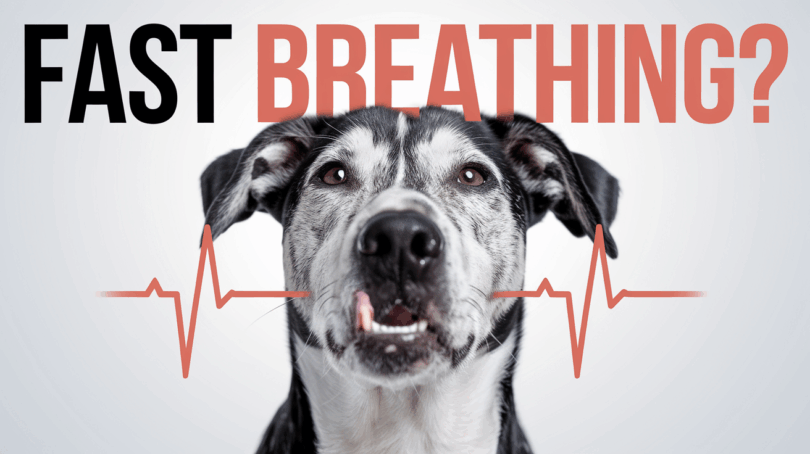Picture this: your furry companion rests beside you, their chest rising and falling quicker than usual. No tongue lolling, no typical signs of exertion—just a steady, rapid rhythm that feels… off. Many pet owners face this quiet moment of uncertainty, wondering whether their four-legged friend needs help or is simply having a calm day.
Changes in a canine’s respiratory rate often signal subtle shifts in their well-being. While occasional variations are normal, persistent rapid breaths without panting can hint at underlying conditions. Recognizing what’s typical for your pet—and what isn’t—is the first step toward safeguarding their health.
This guide clarifies how to distinguish harmless behavior from potential red flags. You’ll learn about common triggers, from stress to systemic issues, and when to seek veterinary care. Knowledge empowers you to act decisively, ensuring your companion stays happy and healthy.
Whether you’re a new pet parent or a seasoned caregiver, understanding these patterns fosters confidence. Let’s explore how to decode your pal’s silent messages and respond with care.
Understanding Dog Breathing Behaviors
A calm, resting pet offers a window into their baseline health. Observing their chest movements helps owners recognize what’s typical versus unusual. Most healthy pets take 15 to 35 breaths per minute when relaxed—slower than during play or walks.
Defining Standard Respiratory Rates
At rest, a normal rhythm involves steady, quiet inhalations through the nose. Activity or excitement naturally increases this rate temporarily. For example, after fetch sessions, counts might reach 200 breaths per minute without indicating distress. Stressors like thunderstorms can also elevate numbers briefly.
Thermoregulation Through Rapid Breathing
Panting allows evaporation from the tongue and airways, cooling blood before it circulates. This process prevents overheating during exercise or in warm environments. Unlike distress-related rapid breathing, temperature regulation involves open-mouthed, shallow breaths with no audible congestion.
Misconceptions arise when owners mistake situational panting for emergencies. Context matters: a pup napping after a summer stroll might breathe 40 times per minute harmlessly. Persistent rapid breaths without exertion, however, warrant attention.
Normal vs. Abnormal Breathing in Dogs
Recognizing the line between typical respiratory patterns and concerning changes requires careful observation. A resting companion’s chest movements offer vital clues about their health status.
Typical Breathing Rates and Signs
Healthy pets maintain 15-35 breaths per minute when relaxed. Count rises temporarily during play or stress, returning to baseline quickly. Rates exceeding 40 breaths per minute at rest—measured over several minutes—signal potential issues.
When Breathing Changes Signal Trouble
Labored movements, flared nostrils, or blue-tinged gums demand immediate attention. Unusual rhythms like shallow gasps or abdominal heaving often indicate systemic problems. Persistent rapid breathing paired with lethargy or appetite loss warrants veterinary evaluation.
Owners should note changes lasting over an hour or worsening with rest. Context matters: temporary spikes from exercise differ from unexplained acceleration. Early detection of these symptoms helps address underlying conditions effectively.
Common Causes of Fast Breathing in Dogs
Rapid breaths in pets can stem from various factors, both temporary and serious. While some situations resolve on their own, others demand prompt medical care. Identifying the root issue early helps ensure proper treatment and peace of mind.
Exercise and Heat-Related Factors
Playful activities or warm environments often trigger temporary respiratory spikes. A game of fetch or midday sun exposure might push rates higher temporarily. These typically return to normal after rest or cooling down.
Heat stroke remains a critical concern. Overheated pets breathe rapidly to regulate body temperature. Stressful events like fireworks can also cause short-term acceleration without lasting harm.
Pain and Respiratory Conditions
Discomfort from injuries or illnesses like arthritis often increases respiratory effort. Internal issues such as pancreatitis may show no visible signs except faster breaths.
Chronic conditions like congestive heart failure reduce oxygen circulation. This forces the body to compensate through quicker respiration. Respiratory infections—including pneumonia—create similar strain by blocking airways.
Early intervention improves outcomes for serious causes. Veterinary guidance becomes essential when rapid breathing persists alongside lethargy or appetite changes.
Dog breathing fast but not panting: Identifying Unique Signs
Quiet shifts in a pet’s behavior often whisper important clues. Unlike open-mouthed panting from heat or play, rapid breaths with a closed mouth signal something different. These subtle changes—like shallow chest movements or faint wheezing—require careful attention.
A companion may show irregular patterns, such as brief coughing fits during rest. These aren’t typical of temperature regulation. Instead, they might suggest irritation in airways or early-stage respiratory infections. Owners often miss these signs because they’re quieter than standard panting.
Persistent rapid airflow without panting could point to lung inflammation or partial blockages. Obstructions from foreign objects or fluid buildup restrict oxygen exchange. This forces the body to work harder, creating a steady fast rhythm that doesn’t resolve with rest.
Watch for abdominal muscle use during respiration or blue-tinged gums. These red flags often accompany heart conditions or pneumonia. Early detection improves treatment outcomes, making timely vet visits crucial when unusual symptoms linger.
Tracking changes helps differentiate temporary stress from chronic issues. Note frequency, triggers, and accompanying behaviors like reduced appetite. Sharing these details with your veterinarian creates a clearer diagnostic picture for faster intervention.
Recognizing Serious Symptoms and When to Seek Veterinary Help
Sudden shifts in your companion’s behavior can act as silent alarms. While some changes resolve naturally, others demand urgent professional evaluation. Knowing which signs require immediate action helps protect your pet’s well-being.
Key Warning Signs to Monitor
Discolored gums—blue, purple, or pale shades—signal poor blood oxygenation. Open-mouthed breathing while resting often accompanies heart or lung failure. Struggling to lie down or sudden weakness during walks also raise red flags.
Watch for unusual mouth positioning, like extended neck postures during rest. Coughing with blood-tinged mucus suggests internal damage. Rapid weight loss paired with these symptoms heightens urgency.
Persistent symptoms lasting over an hour require veterinary intervention. Delaying care for conditions like respiratory failure risks irreversible harm. Professionals use tools like blood tests and X-rays to pinpoint causes quickly.
Early detection dramatically improves treatment success rates. If your pet shows multiple warning signs, contact a vet immediately. Timely action could save their life and prevent long-term complications.
Diagnostic Approaches Used by Veterinarians
When a pet’s rapid breathing persists without obvious triggers, veterinarians deploy targeted methods to uncover hidden issues. These tools help separate temporary stressors from chronic conditions requiring intervention.
Physical Exams and Advanced Imaging
Initial assessments include listening to heart rhythms and lung sounds using stethoscopes. Vets measure breaths per minute while the animal rests to establish baselines. Chest X-rays then reveal structural abnormalities like fluid buildup or tumors affecting the lungs.
Ultrasound imaging provides real-time views of heart valves and blood flow patterns. This helps identify heart disease early—a common culprit behind irregular breathing. For pneumonia cases, these scans detect inflammation patterns missed by basic exams.
Laboratory Tests and Specialized Procedures
Blood tests analyze oxygen levels in cells and check for infections. Low red blood cell counts often explain labored respiration. Pulse oximeters clipped to ears or paws monitor oxygen saturation noninvasively.
Bronchoscopy allows direct airway inspection using a tiny camera. This procedure collects samples from the lungs to confirm bacterial pneumonia or foreign objects. Combined with other diagnostics, these methods create a clear roadmap for tailored treatments.
Managing Underlying Health Conditions
Effective management of chronic health issues requires tailored strategies that address root causes while supporting overall wellness. Veterinary teams often combine therapies to stabilize pets and improve their comfort. Early intervention plays a critical role in slowing disease progression and maintaining quality of life.
Treatment Options for Heart and Lung Issues
Heart disease often responds well to medications that improve blood flow and reduce fluid buildup. Diuretics help manage congestion in the lungs, while ACE inhibitors support healthy blood pressure. Regular echocardiograms track heart function, allowing vets to adjust dosages as needed.
Medication, Oxygen Therapy, and More
Respiratory conditions may require bronchodilators to open airways or antibiotics for infections. Oxygen therapy provides immediate relief during crises by boosting blood oxygen levels. Nebulizers deliver targeted medication directly to inflamed lung tissues.
Supportive care includes weight management to reduce strain on the body and controlled exercise plans. Pets with chronic conditions benefit from routine checkups to catch changes early. Many show marked improvement in energy and appetite once treatments begin.
Owners play a vital role by monitoring breathing rates and reporting changes. Small adjustments in medication timing or environmental factors often make significant differences. Consistent care helps pets enjoy active lives despite health challenges.
Home Care and Preventative Measures for Respiratory Health
Proactive care at home plays a vital role in maintaining your companion’s respiratory wellness. Simple daily habits help catch subtle changes early while creating an environment that supports healthy airflow.
Daily Monitoring and At-Home Care Strategies
Track resting respiratory rates by counting chest movements for 60 seconds when your pet naps. Aim for 15-35 breaths per minute as a baseline. Note any sustained increases during calm moments.
Create stress-free zones by minimizing loud noises and sudden schedule changes. During heatwaves or cold snaps, adjust outdoor activity times to cooler morning or evening hours. This reduces environmental strain on their system.
Inspect the nose area daily for unusual discharge or crusting. Persistent sneezing or dry nostrils could signal irritation. Keep living spaces free from smoke, aerosols, or dusty bedding that might affect airways.
Watch for vomiting episodes accompanied by rapid chest movements. These may indicate nausea linked to respiratory distress. Maintain consistent meal schedules and hydration to support overall health.
Combine these steps with regular veterinary checkups for comprehensive care. Share your observations about breathing patterns, activity levels, and nasal changes during appointments. Early collaboration with professionals ensures the best outcomes.
Final Thoughts on Ensuring Your Dog’s Well-Being
Monitoring your pet’s respiratory health is a cornerstone of proactive care. Throughout this guide, we’ve explored how stress, infections, or conditions like congestive heart disease can alter normal patterns. Recognizing these shifts early—especially changes in chest movements or persistent heavy breathing—helps owners act swiftly.
Timely intervention often makes the difference between manageable issues and emergencies. For example, a resting rate exceeding 40 breaths per minute could signal fluid buildup or oxygen deprivation. Trust your instincts: unexplained acceleration lasting over an hour warrants veterinary guidance.
Stay observant by tracking respiratory rates during calm moments. Note triggers like heat exposure or activity levels. Share these details with your vet to pinpoint hidden problems, from airway obstructions to systemic conditions.
Every minute matters when addressing respiratory distress. Pair routine checks with preventive measures—avoiding extreme temperatures and reducing environmental irritants. By staying informed and responsive, you empower yourself to safeguard your companion’s well-being effectively.
FAQ
How can I tell if my pet’s rapid breathing is normal or concerning?
Monitor their respiratory rate at rest—healthy adults typically take 15–30 breaths per minute. Persistent rates above 40 breaths/minute, shallow breaths, or blue-tinged gums require immediate veterinary attention. Context matters: check for triggers like heat, stress, or recent activity.
What conditions cause accelerated breathing without panting?
Respiratory infections, heart disease, anemia, or pleural effusion (fluid around lungs) often trigger this pattern. Pain from injuries or abdominal bloating may also lead to fast, quiet breaths. X-rays or ultrasounds help vets identify underlying issues like pneumonia or congestive heart failure.
Are certain breeds more prone to breathing difficulties?
Brachycephalic breeds (e.g., Bulldogs, Pugs) face higher risks due to narrowed airways. Dogs with heart conditions, like Cavalier King Charles Spaniels, may develop fluid retention affecting lung function. Regular checkups help manage breed-specific vulnerabilities.
What emergency signs accompany dangerous breathing changes?
Labored chest movements, coughing up foam, collapsing, or open-mouth breathing at rest signal critical issues. Pale or bluish mucous membranes indicate poor oxygenation. These require urgent care to address potential organ failure or respiratory collapse.










Leave a Comment